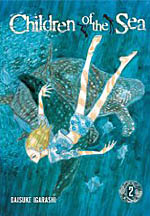 By Daisuke Igarashi
By Daisuke Igarashi
320 pages, black and white
Published by Viz
I’m finding myself continually loving Viz’s new online IKKI magazine, serializing all sorts of off-beat and different Japanese comics for free. As time goes on, though, we’re eventually seeing collected editions of these comics hit stores. It’s a pleasure to see Children of the Sea already on its second volume, because it and Saturn Apartments regularly vie for the title of my favorite IKKI comic. Chances are, it’s whichever just released a new chapter. And while not overtly full of environmental themes (or at least not yet), its looking towards the ocean in this day and age seems particularly timely.
What I find myself always being drawn to in Children of the Sea is how Daisuke Igarashi manages to focus in on the mystery of the ocean and make it such an integral part of the story. It’s the closest we probably have to something that can serve as being both familiar and alien in one fell swoop; after all, most people have seen the ocean (or at least a lake or particularly large river), but its depths seem to hold an almost universal sense of mystery and wonder. Igarashi taps into that feeling here, plunging the reader into the waters with the continual hint of mystery. Then again, water is present everywhere in Children of the Sea. Even when the characters aren’t actually at the ocean, massive storms that last several chapters rage down upon the characters, almost as if the ocean has risen up around people who doubt its power and influence.
While the ocean might be the most prominent character in the story, Ruka is a good protagonist in her own right. Igarashi took the tactic of making her an outsider that is slowly learning about these strange aquatic children, and it works as a gateway for the reader to learn alongside Ruka. Some of Ruka’s fire from the first volume seems muted here, but at the same time it makes sense. When Children of the Sea began, Ruka clearly had no attachments to other people on an emotional level, and it’s her interactions with Umi and Sora that seem to calm her down and keep her focused on the situations at hand. It’s also probably because Igarashi isn’t afraid to advance the plot at a rapid rate. When you’re first reading Children of the Sea it may feel like it’s at a leisurely, careful pace, but upon re-reading this volume in collected form I was surprised at the changes we’ve already seen in the basic set-up since that first chapter.
I absolutely adore Igarashi’s art here. It’s a sketchy, thin-lined style that at a glance almost appears to be scribbled onto the page. As you look closer, though, you start seeing the connections from one figure to the next, and the immense detail that’s lurking on the pages. With portions of the book taking place underwater, Igarashi made sure to nail drawing scenes there; with a dark shade over the entire page, Igarashi is able to somehow bring across the sensations of filtered light, muted sounds, and increasing pressure all around you. He’s just as good up on land, of course. Umi and Sora manage to both look human and slightly alien under his pen, and the scenes of ghost animals floating through the air amidst the rain storm are suitably creepy.
With siren calls and flying marine life, Children of the Sea feels almost like a forgotten Hayao Miyazaki movie. I have absolutely no idea what’s in store for the characters here, and I say that with excitement. Igarashi is telling a lush, beautifully realized comic and it’s easy to see why it’s the centerpiece of the IKKI website. With the first chapter kept up there permanently, it’s a great way to dip in and see if you’re interested in more; I know I want to see a lot more. Children of the Sea is a beautiful book from cover to cover. Highly recommended.
Purchase Links: Amazon.com | Powell’s Books
